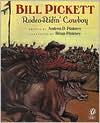- publisher and date: Gulliver Books, 1996
- genre: biography
- age/grade: grades 4-6
Synopsis (from http://www.bn.com)
The true sweat-and dirt tale of the feisty cowboy-child who become the most famous black rodeo performer who ever lived.
Author’s Perspective: (from: Voices from the Gaps)
Andrea Davis Pinkney was born on September 25, 1963 in Washington, D.C., the daughter of parents deeply involved in the civil rights movement. As a result, Pinkney was exposed to the movement at a young age and was even involved in the annual conference of the National Urban League during many of her summer vacations. The Civil Rights Movement played a large role in her childhood and its influence is visible in many of her books.
Literary Elements:
Essential Qualities– Bill Pickett came alive in the text. A bibliography for further reading has 10 books listed. There is also a 2 page “More About Black Cowboys” section at the end of the book that provides more detailed information. I learned a lot about a subject I knew nothing about!
Style/Tone – It has a storytelling feel to it. There is a definite Andrea Davis Pinkney feel to it. Some examples from the text are:
- He was quick as a jackrabbit, more wide-eyed than a hooty owl – and curious. (page 3)
- The cowboys turned out a rip-roarin’ laugh. (page11)
- … keep folks yip-yapping for more. (page 22)
Curriculum Connections:
- Painted Essay – Use examples from the text to support the focus: Bill Picket followed his dream to become a cowboy.
- Compare/Contrast – Compare and contrast Bill Pickett and Benjamin Banneker. How were they similar? How were they different?
- Poster – Make a poster advertising Bill Pickett and his bulldogging.
- Newspaper article – In the text, it said: “The Wyoming Tribune and the Denver Post printed stories about the wild-riding South Texas brushpopper who could tackle a steer with his bare hands, and his bite.”
Web Resources:
- Bill Pickett biography
- Bill Pickett biography from Bill Pickett Invitational Rodeo
- Bill Pickett Postal Stamp Error
Reviews:School Library Journal (from www.amazon.com) Kindergarten-Grade 3?Bill Pickett was a rodeo cowboy in the days when black men were not allowed to do much of anything that wasn’t menial or demeaning. Pickett, however, followed his dream. As a young boy, he would watch cowboys herd cattle past his parents’ farm and dream of becoming a cowboy. One day, Bill helped some cowboys bulldog a calf they were having trouble branding. They were suitably impressed with his skills, and there was no stopping him after that. By the age of 15, he had left home to work on ranches throughout Texas. His fame grew steadily, and eventually he was offered a job in a rodeo. After just a few years, he was famous throughout the country, even riding in Mexico, South America, and England. His fame not only helped popularize rodeo, but helped to give attention to a black man in a very racist time. This is a brilliantly done tribute to an unjustly forgotten pioneer. The text is fascinating, and the oil paintings on scratchboard are full of energy and motion, matching the book’s powerful mood. A wonderful choice for any collection.?Melissa Hudak, North Suburban District Library, Roscoe, IL
Copyright 1996 Reed Business Information, Inc. –This text refers to an out of print or unavailable edition of this title.
